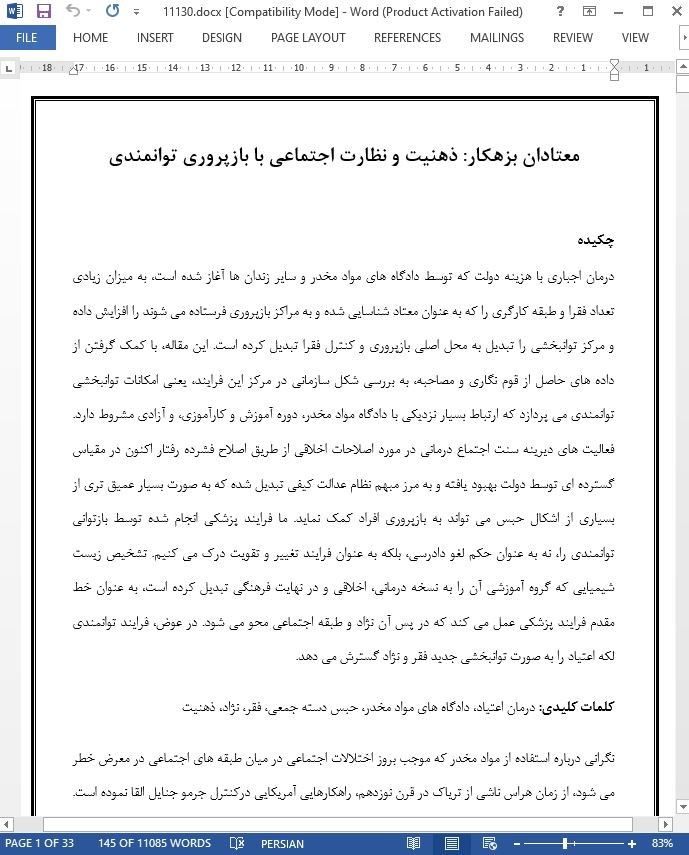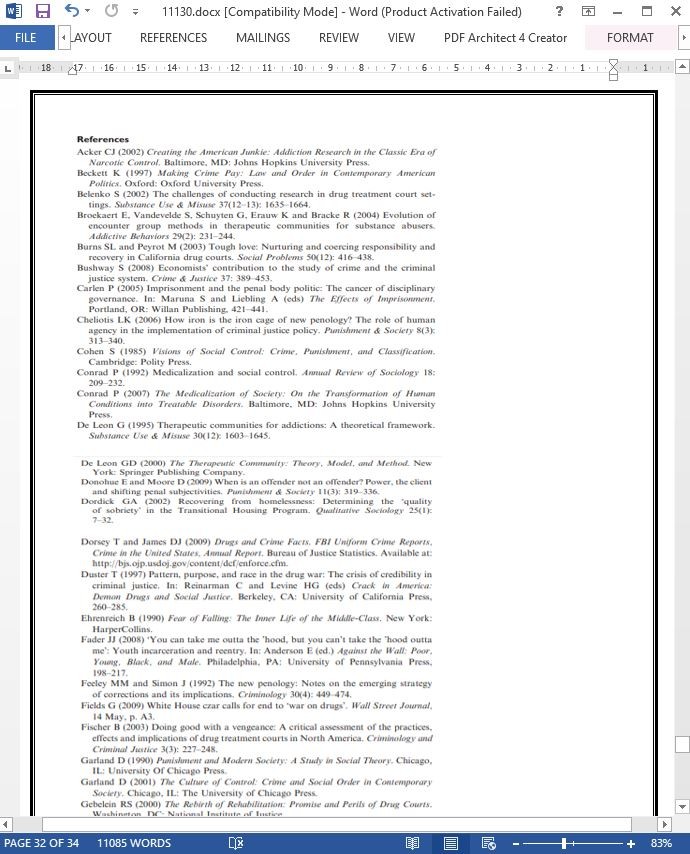
معتادان بزهکار: ذهنیت و نظارت اجتماعی با بازپروری توانمندی
چکیده
درمان اجباری با هزینه دولت که توسط دادگاه های مواد مخدر و سایر زندان ها آغاز شده است، به میزان زیادی تعداد فقرا و طبقه کارگری را که به عنوان معتاد شناسایی شده و به مراکز بازپروری فرستاده می شوند را افزایش داده و مرکز توانبخشی را تبدیل به محل اصلی بازپروری و کنترل فقرا تبدیل کرده است. این مقاله، با کمک گرفتن از داده های حاصل از قوم نگاری و مصاحبه، به بررسی شکل سازمانی در مرکز این فرایند، یعنی امکانات توانبخشی توانمندی می پردازد که ارتباط بسیار نزدیکی با دادگاه مواد مخدر، دوره آموزش و کارآموزی، و آزادی مشروط دارد. فعالیت های دیرینه سنت اجتماع درمانی در مورد اصلاحات اخلاقی از طریق اصلاح فشرده رفتار اکنون در مقیاس گسترده ای توسط دولت بهبود یافته و به مرز مبهم نظام عدالت کیفی تبدیل شده که به صورت بسیار عمیق تری از بسیاری از اشکال حبس می تواند به بازپروری افراد کمک نماید. ما فرایند پزشکی انجام شده توسط بازتوانی توانمندی را، نه به عنوان حکم لغو دادرسی، بلکه به عنوان فرایند تغییر و تقویت درک می کنیم. تشخیص زیست شیمیایی که گروه آموزشی آن را به نسخه درمانی، اخلاقی و در نهایت فرهنگی تبدیل کرده است، به عنوان خط مقدم فرایند پزشکی عمل می کند که در پس آن نژاد و طبقه اجتماعی محو می شود. در عوض، فرایند توانمندی لکه اعتیاد را به صورت توانبخشی جدید فقر و نژاد گسترش می دهد.
نگرانی درباره استفاده از مواد مخدر که موجب بروز اختلالات اجتماعی در میان طبقه های اجتماعی در معرض خطر می شود، از زمان هراس ناشی از تریاک در قرن نوزدهم، راهکارهایی آمریکایی درکنترل جرمو جنایل القا نموده است. با این حال، در دوره حاضر با حبس های بیش از حد، جلوگیری از مصرف مواد مخدر نقش بسیار مهم تری به خود اختصاص داده است. از زمان عملیات پیشگیری نیکسون در سال 1969، دولت ایالات متحده حدود یک تریلیون دلار برای جلوگیری، مجازات، یا درمان سوء مصرف مواد مخدر هزینه کرده است. مقامات دولتی، طرفداران سلامت عمومی، و رسانه های گروهی نگرانی مردم را در مورد مواد مخدر به عنوان خطر اصلی برای ثبات جامعه برانگیخته و مبارزه ای ملی را آغاز کرده اند که از اساس الگوهای دستگیری و محکومیت را منحرف کرده است. از سال 1980 تاکنون، این راهکار به افزایش ده برابری در محکومیت های مربوط به جرائم مواد مخدر منجر شده است که بسیاری را برای اولین بار به زندان انداخته و جریان مداومی از مردان و زنان آسیب دیده را به مناطق فقیرنشین و طبقه کارگر بازگردانده است.
فقدان انکار یا انکار فقدان؟
تردیدی نیست که مصرف بیش از حد مواد دلیل اصلی رفتار جنایتکاری بسیاری از آمریکایی ها است و برنامه درمانی می تواند فرصتی حیاتی را برای پایان بخشیدن و فراغت از اثرات مخرب حبس فراهم آورد. با این حال، تاثیرات بازپروری توانمندی بر هزینه های اصلاحات و نرخ جنایت پیشگی کمتر مشهود است. در مورد خود ما، یک سال پس از برگزاری اولین دادگاه واد مخدر کشور در سال 1997، تعقیب قانونی جرائم مرتبط با مواد مخدر تا 50 درصد افزایش یافت و به رشد صعودی خود نیز ادامه داده است. از آن جا که ما شاهد بودیم که مددجویان برای سومین بار، دوازدهمین بار و حتی هجدهمین بار توسط دادگاه بازگردانده می شدند، مراقبت ادعایی مانند دری چرخان به نظر می رسید. مطمئنا، بسیاری از مددجویان موسسه را تنها به عنوان شکل دیگری از حبس در نظر می گرفتند.
Abstract
The mandatory, state-subsidized treatment opened up by drug courts and other jail and prison diversion programs have massively expanded the numbers of the nation’s poor and working class who are labeled addicts and sent to rehab, making drug rehabilitation a primary site for the re-socialization and control of the poor. Drawing on ethnographic and interview data, this article examines the institutional form at the center of this process: the ‘strong-arm’ rehabilitation facilities most closely tied to drug courts, probation, and parole. The therapeutic community tradition’s long-standing practices of moral reform through intensive behavior modification are now mobilized by the state on a large scale, transformed into a ‘fuzzy edge’ of the criminal justice system which resocializes far more intensively than most forms of incarceration. We understand the ‘medicalization’ represented by strong-arm rehab not as a reprieve from judgment, but instead as a process of translation and amplification. Translated by staff into therapeutic, moral, and finally cultural versions, the biochemical ‘diagnosis’ of pathology comes to serve as a neutral, medicalized front behind which the systemic injuries of race and class disappear. Instead, the strongarm process amplifies the taint of addiction into a new biologization of poverty and race.
Anxieties about drug use creating social disorder among the ‘dangerous classes’ have infused American strategies in crime control since the opium scares of the 19th century. Within the current era of hyper-incarceration, though, the suppression of drug use has taken a far more central role. Since Nixon’s Operation Intercept of 1969, the US government has spent roughly one trillion dollars to suppress, punish, or treat illicit substance abuse (Fields, 2009). Government officials, public health advocates, and mass media have mobilized public anxieties about drugs as a central threat to social stability, producing a national crusade which has radically skewed patterns of arrest and sentencing. To date, this strategy has culminated in a more than 10-fold increase in drug crime incarceration since 1980 (Western, 2007), imprisoning many for the first time, and returning a steady flow of often-traumatized men and women into poor and working-class areas (Acker, 2002; Beckett, 1997; Duster, 1997; Macek, 2006; Reinarman, 2005; Simon, 2007; Tonry, 2011).
The poverty of ‘denial’ or the denial of poverty?
There is little doubt that problematic drug use is a central cause of criminalization for many Americans, and treatment can offer a crucial opportunity for healing and a respite from the destructive effects of incarceration. Yet the effects of strong-arm rehab on correctional expenditures and recidivism rates are less clear. In our own case, one year after the implementation of the county’s first drug court in 1997, drug crime prosecutions rose by 50 percent, and have continued to climb. As we watched clients returned by the court for their third, 12th, and even 18th attempt at rehab, the purported cure looked more like a revolving door. Certainly many of the clients saw the institution as just another form of incarceration.
چکیده
جریان سازی درمانی
از دوستداران آرمان گرا تا زندان کشور تابع
سایت های پژوهشی و روش شناسی
تشخیص معتاد بزهکار
بازپروری یا تولد دوباره
من گفتم او را به زندان بازگردانند
فقدان انکار یا انکار فقدان؟
نکات
Abstract
Mainstreaming the therapeutic?
From utopian cult to satellite prison
Research sites and methodology
Diagnosing the ‘criminal addict’
Rehabilitation as rebirth
I say send him back to prison
The poverty of ‘denial’ or the denial of poverty?
- اصل مقاله انگلیسی با فرمت ورد (word) با قابلیت ویرایش
- ترجمه فارسی مقاله با فرمت ورد (word) با قابلیت ویرایش، بدون آرم سایت ای ترجمه
- ترجمه فارسی مقاله با فرمت pdf، بدون آرم سایت ای ترجمه


